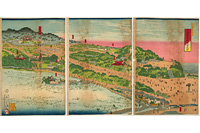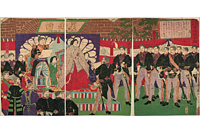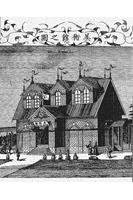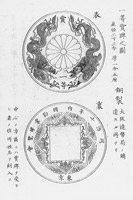First National Industrial Exhibition
For promotion of industries
- Period
- : August 21, 1877 - November 30, 1877
- Venue
- : Tokyo Ueno Park
- No. of visitors
- : 454,168
In August 1877, when the Seinan Civil War (Satsuma Rebellion) was being fought in Japan, the opening ceremony of the country's first National Industrial Exhibition was held. This national event was promoted by Toshimichi Okubo, the first minister of the Naimu-sho (Ministry of Home Affairs), with reference to the Vienna International Exposition of 1873, in which Japan had participated.
Although events called "expositions" had been held in Japan, most of them comprised shows featuring renowned treasures and curiosities. As indicated by the inclusion of the word "industrial" in its name, however, the National Industrial Exhibition completely removed the image of a "show" from the exhibits; such an image was unnecessary for the promotion of industries. The national event emphasized its aspect as an industrial promotion opportunity providing a meeting place for Western technologies and their Japanese counterparts.
The approximately 100,000 m2 venue contained the Fine Art Building, the Agricultural Production Building, the Machinery Building, the Horticultural Building, and the Animal Building. A big clock was placed on the top of the front gate of the former abbot residence of Kan'eiji Temple. An approximately 10 m high American-style windmill (for pumping up groundwater) was constructed at the park entrance. Also, thousands of lanterns were strung across the street from Ueno-Toshogu-mae to the Park.
As in the case of the Philadelphia International Exposition of 1876, all the exhibits collected from across Japan were categorized roughly into six groups (mining and metallurgy, manufactures, fine art, machinery, agriculture, and horticulture). They were judged based on the criteria of materials, manufacturing methods, quality, adjustment, effectiveness, value and price. Medals, certificates of merit and other honors were bestowed on excellent exhibits. It can be said that the National Industrial Exhibition was a good opportunity to conduct the product survey and industry promotion at the same time.
At the event, where many of the items were exhibited by the spinning and weaving-related industry, Tatchi Gaun was granted the Homon (Phoenix) Medal, highest honor at the exposition. He is one of the figures referred to most frequently when the Japanese patent system is discussed. (Column: Patent System in the Meiji Period)
The first National Industrial Exhibition considerably influenced the promotion of Japanese industries, serving as a model for subsequent expositions held in the country.
- References:
Kuni, Takeyuki.: Hakurankai no jidai: Meiji seihu no hakurankai seisaku (Iwata shoin, 2005) <D7-H68>
Kuni, Takeyuki, Tokyo toritsu tanki daigaku.: Kindai nihon to hakurankai - Meiji seihu no naikoku kangyo hakurankai, bankoku hakurankai, kyoshinkai seisaku (Reports under Grants-in-Aid for Scientific Research from the Ministry of Education, 1999-2002) <Y151-H11610365>
Yoshida, Mitsukuni.: Bankoku hakurankai: Gijutsu bunmeishiteki ni Revised ed. (Nihon hoso shuppan kyokai, 1985) <D7-67>
Yoshida, Mitsukuni (ed).: Zusetsu bankoku hakurankaishi: 1851-1942 (Shibunkaku shuppan, 1985) <D7-66>
Yoshimi, Toshiya.: Toshi no doramaturugi: Tokyo sakariba no shakaishi (Kawade syobo shinsha, 2008) <EC122-J31>





